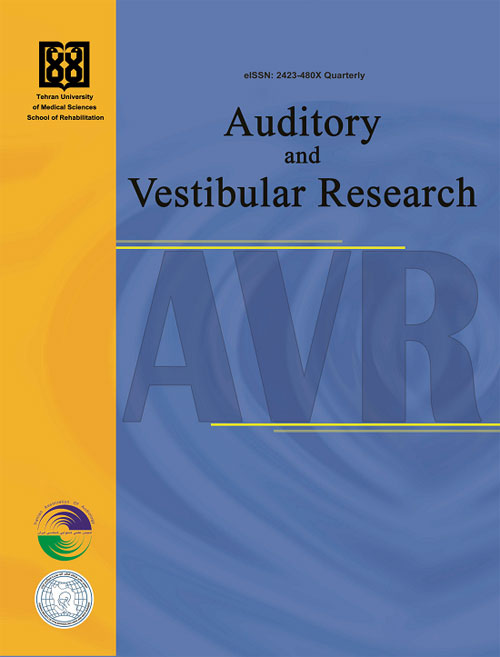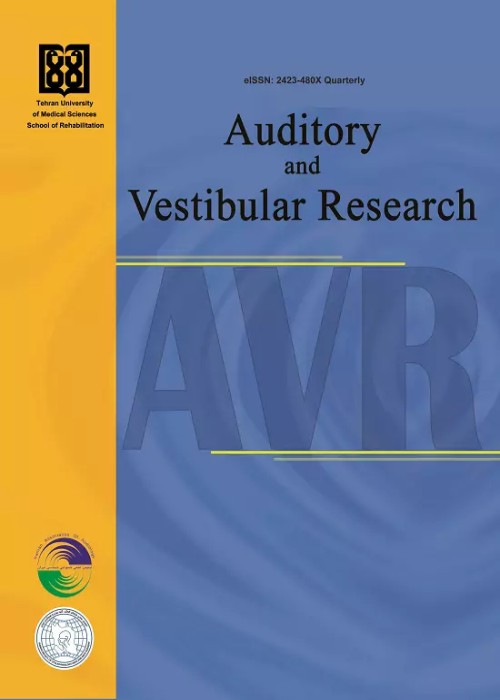فهرست مطالب

Auditory and Vestibular Research
Volume:28 Issue: 3, Summer 2019
- تاریخ انتشار: 1398/04/17
- تعداد عناوین: 8
-
-
Pages 134-145Background and AimResearchers in the fields of psychoacoustic and electrophysiology are mostly focused on demonstrating the better and different neurophysiological performance of musicians. The present study explores the impact of music upon the auditory system, the non-auditory system as well as the improvement of language and cognitive skills following listening to music or receiving music training.Recent FindingsStudies indicate the impact of music upon the auditory processing from the cochlea to secondary auditory cortex and other parts of the brain. Besides, the impact of music on speech perception and other cognitive processing is demonstrated. Some papers point to the bottom-up and some others to the top-down processing, which is explained in detail.ConclusionListening to music and receiving music training, in the long run, creates plasticity from the cochlea to the auditory cortex. Since the auditory path of musical sounds overlaps functionally with that of speech path, music helps better speech perception, too. Both perceptual and cognitive functions are involved in this process. Music engages a large area of the brain, so music can be used as a supplement in rehabilitation programs and helps the improvement of speech and language skills.Keywords: Auditory processing, speech perception, music
-
Pages 146-157Background and AimMost elderly people in noisy environments complain of speech comprehension. At present, hearing aids or cochlear implants are the main treatment options. However, these devices merely enhance sound audibility and do not compensate for central processing changes caused by aging, hearing loss, or cognitive decline. This article reviewed plasticity topic in the auditory system and the use of auditory evoked potentials to prove the effectiveness of auditory training.Recent FindingsThe search for relevant articles in the Google Scholar, PubMed, Springer, and ProQuest databases was conducted with the keywords of “auditory education,” “electrophysiology,” “plasticity,” and “aging.” A total of 107 articles were found with these keywords, and finally, 98 articles, published between 1977 and 2018, were used. Existence of plasticity in the central auditory system, regardless of age, has been proven. Therefore, cognitive and auditory training to reduce cognitive problems and improve central hearing processing in appropriate cases can positively affect the quality of hearing and social communication of the elderly. Because efficacy is an important component of any therapeutic approach, the assessment of the benefits of hearing training can be demonstrated by electrophysiological tests.ConclusionAuditory training may play an important role in the elderly treatment program with speech perception defects. The usefulness of this rehabilitation can be objectively evaluated through cortical and subcortical electrophysiological methods.Keywords: Auditory training, electrophysiology, plasticity, aging
-
Pages 158-163Background and AimChildren with intellectual disability have significant defects in the essential elements that constitute mental development. The purpose of this study was to investigate the effectiveness of applied behavior analysis on inhibition, planning, and working memory of intellectually disabled children with hearing impairment.MethodsThe study design was quasi-experimental with pretest, posttest and a group control. The study population comprised all intellectually disabled children with hearing impairment, referred to Yazd Rehabilitation Centers. A total of 30 students were selected from the hearing-impaired children with mild to moderate intellectual disability. Then, they were randomly assigned into control (n = 15) and experimental (n = 15) groups. The study instrument was the Behavior Rating Inventory of Executive Function (BRIEF) questionnaire. The program based on applied behavior analysis presented for experimental group and after that the posttest were administered for both groups. Analyses of covariance was used to analyze data.ResultsThe study result indicate that group therapy based on applied behavior analysis has significant effects on inhibition (p < 0.01) and planning (p < 0.05) of intellectually disabled children with hearing impairment, but cannot change their working memory (p < 0.17).ConclusionApplied behavior analysis can be used as a therapeutic method for improving exe cutive functions in intellectually disabled children with hearing impairment.Keywords: Applied behavior analysis, intellectual disability children, inhibition, working memory
-
Pages 164-172Background and AimOne of the common behavioral disorders of hearing-impaired children is aggressive behavior, which can affect social adjustment in their adolescence. This study was designed to investigate the effectiveness of group counseling based on problem-solving on aggression and social adjustment of hearing-impaired students.MethodsThis study is quasi-experimental with pretest posttest design and a control group. The study population was all adolescents with hearing impairment referred to Yazd Speech Therapy Centers, Yazd City, Iran. A total of 30 students were selected from the referred hearing-impaired students with high aggression and low social adjustment. Then they were randomly assigned into control (n = 15) and experimental (n = 15) groups. The study instruments were the California social behavior and Buss and Perry aggression inventory. The group counseling based on problem-solving intervention consisted of 7 one-hour sessions, presented for the experimental group. We analyzed the obtained data by repeated measures analysis of covariance.ResultsGroup therapy based on problem-solving can reduce aggression (p < 0.001) and increase social adjustment (p = 0.04).ConclusionThe professionals in this field are recommended to use group therapy based on problem-solving.Keywords: Group counseling, problem-solving, aggression, social adjustment, hearing impairment
-
Pages 173-181Background and AimThe quick speech in noise (Q-SIN) test shows the difficulty of speech perception in noise by specifying signal to noise ratio (SNR) loss. Although the Persian version of Q-SIN has been already constructed, the high-frequency emphasis version of this test is not available. The present study aimed to construct six lists with high-frequency emphasis and implement it.MethodsWe are going to prepare a high-frequency emphasis version of Q-SIN and then test
it on a small sample. First, researchers designed the relevant sentences; then experts examined their content and face validity. According to the criteria for developing the Q-SIN test, six lists with high-frequency emphasis were prepared. The test was examined on 26 (13 male and 13 female), 18−35 years old individuals with normal hearing. To determine the test reliability, it was re-administered three weeks later with the same conditions.ResultsOf 76 sentences prepared, 36 sentences received enough credit after determination of their content and face validity. These 36 sentences were used to make 6 lists. The mean value of SNR50 in the Persian language was obtained -4 dB. The mean values of SNR loss in 6 lists were -1.65, -1.8, -2.23, -1.61, -2.38 and -2.07. The results showed equivalency of lists 1, 2, 3, 4, and 6. Examination of test-retest reliability indicated that all lists except the list 2were reliable.ConclusionThe lists of 1, 3, 4, and 6 are reli able and equivalent and can be used in clinical application.Keywords: Equivalency, normal hearing, quick speech-in-noise test, reliability, signal to noise ratio loss -
Pages 182-189Background and AimTinnitus is an annoying distressing phantom phenomenon that can cause major problems, such as insomnia and sleep deprivation. Therefore, the present study was conducted to determine the effects of cognitive-behavioral training (CBT) and muscle relaxation on the level of tinnitus and the quality of sleep in patients with tinnitus in Ahvaz City in 2018−2019.MethodsThis study is a semi-experimental, pretest, post-test, and follow-up with control group. There are two experimental groups and one control group in this plan. Participants in the first experimental group received eight sessions of CBT and participants in the second experimental group received eight sessions of relaxation training. Control group were not subject to any intervention.ResultsThe results of this study showed that cognitive-behavioral approach and muscle relaxation have reduced the amount of tinnitus and increased sleep quality using multivariate covariance analysis. The most important results of this study are the effectiveness and usefulness of cognitive-behavioral approach and muscle relaxation on reducing tinnitus and increasing the quality of sleep.ConclusionCognitive-behavioral therapy and muscle relaxation approaches were effective in improving tinnitus and quality of sleep. More attention and emphasize in these approaches will be a good alternative to some invasive (electric stimulation) or with some side-effects (drug therapy) approaches.Keywords: Cognitive-behavioral training, muscle relaxation, tinnitus, sleep quality
-
Pages 190-197Background and AimTemporal processing is affected in people exposed to occupational noise. The primary goal of this study was to evaluate the temporal processing of people exposed to occupational noise of more than 85 dB A but have not experienced clinically significant changes at hearing thresholds at conventional frequencies.MethodsA comparison between groups were designed using individuals exposed to occupational noise (n = 15 as the case group) and non-exposed individuals (n = 16 as the control gro up). Two groups were age-matched (p < 0.05). The extended high-frequency audiometric thre sholds and temporal processing system were evaluated through a duration pattern sequence test. Finally, the correlation between the extended high-frequency hearing thresholds and the duration pattern test scores was investigated.ResultsThe case group had significantly higher hearing thresholds than the control group at 14, 15, and 16 kHz (p < 0.05). Although in other frequencies, the mean hearing thresholds in the case group was higher than the control group, the difference was not significant. Also, the case group had significantly lower duration pattern sequence scores than the control group in the right (p = 0.02) and the left ears (p = 0.03). There was no correlation between extended high-frequency hearing thresholds and duration pattern sequence test scores.ConclusionIn people exposed to occupational noise, both extended high-frequency thresholds and temporal processing in lower frequency ran ges (with normal hearing thresholds) are interrupted.Keywords: Occupational noise, extended high-frequency hearing, duration pattern sequence test, temporal processing
-
Pages 198-203Background and AimChildren with sensory impairments can bring stress to their parents. The purpose of this study was to compare perceived social support in mothers of children with hearing impairment, visual impairment, and typically developing children in Shiraz City, Iran.MethodsThe study sample consisted of 139 mothers of normal children and children with sensory impairment (50 mothers of children with hearing impairment, 39 mothers of children with visual impairment, and 50 mothers of typically developing children). The Multidimensional Scale of Perceived Social Support was used to measure perceived social support. One-way ANOVA and multivariate analysis of variance (MANOVA) were respectively used for analyzing the total score of perceived social support and the scores of its subscales.ResultsThe results showed that there was a significant difference between perceived social support and its subscales among mothers of children with hearing impairment, mothers of chi ldren with visual impairment and mothers of typically developing children. So, perceived social support and its subscales in mothers of children with hearing impairment and mothers of children with visual impairment are significantly lower than mothers of typically developing children (p < 0.01). It should be noted that there was no significant difference in perceived social support between mothers of children with hearing impairment and mothers of children with visual impairment.ConclusionThe provision of counseling services and the implementation of appropriate interventions for mothers of children with hearing impairment and mothers of children with visual impairment is necessary.Keywords: Perceived social support, mothers, children, hearing impairment, visual impairment


